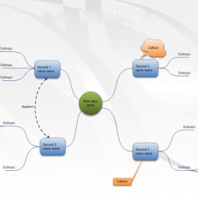An Overview
The word, Mind Map immediately conjures up a graphic image of a human mind. In simpler terms, a Mind Map is a graphical representation of words, jobs and concepts that are connected and surround a central key word or an idea. Basically, a mind map is a physically drawn diagram and is used to visualize, classify and set up ideas and serve to be a helping hand in arranging information, providing solution to problems, writing and studying as well as arriving at a logical decision.
Attributes of Mind Map
A mind map involves making of hand written notes through graphical methods and generally represented through symbols, lines and colors. Mind maps, through their visual mode, assist another person to make sense of a formative idea that is taking place in a person’s mind. Mind Maps are usually prepared in a hierarchical or tree-like structure with concepts branching off in sub-sets. There is a lot of creativity involved in producing mind maps. While recording information and ideas, it permits the creator to lend a graphic touch to his visual representations. One of the major differences that lie between a concept map and a mind map is that mind maps concentrate only on a single word or a concept while concept maps link multiple words or ideas. One other distinctive purpose of a mind map is that it assists with memory and arrangement. Mind maps are essentially a collection of words that are well thought out with visuals in color, icons and informal visual connections that are essential for the correct working of the mind map.
Elements of a Mind Map
Mind maps help in recalling of pre-existing memories of the mind map creator. There is an excellent arrangement of the ideas that are set up in accordance to the significance of the concept and are segregated into groups, branches or areas. This achieves the aim of representing semantic and other links lying between parts of the information.
Mind maps also inculcate an approach of brainstorming towards organizational task and proper planning through their presentation of ideas in graphical, non-linear and radial methods. Although the branches of a mind map portray a hierarchical tree like structure, the radial arrangement disturbs the lining up of the basic ideas that are particularly related with the hierarchical structure presented with visual cues of linear nature.
Mind map guidelines
There is a set of guidelines that are essential for creating a mind map.
Always start in the center with the topic shown through an image; three colors are to be used. Appropriately use images, symbols, codes and dimensions throughout the creation of a mind map. Selected keywords should be printed in both upper and lower case letters. There should be appropriate linkages between the images starting from the core image. The links shown through lines should be thicker from the centre and become thinner as they move out from the center. Sharp colors and tints add stimulation to the viewer and arouse his interest; colors should also be used for encoding or grouping. Each creator of mind map has a unique style of his own and he displays his best methods of creation.
Advantages
Mind maps are generally utilized for offering solutions to problems, providing an outline or a pattern, representations of relationship or structure, a symbiosis of words and visuals, an expression of creativity and an enhancement of morale to work and a team building exercise.
Suggested References:
Books
- https://www.mapyourmind.com/ebook.pdf
- Mind Maps at Work: How to Be the Best at Your Job and Still Have Time to Play
- Tony Buzan (Author)
- Tony and Barry Buzan, The Mind Map Book
- Tony Buzan, Use Your Head
https://bookmytrainings.com/mind-maps
[lastupdated]
